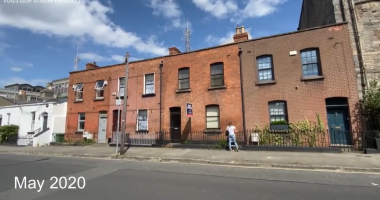THE Bank of England has teased the release of its new plastic £50 note in a cryptic binary code message posted on social media.
The central bank has long been expected to release its final polymer note into circulation some time in 2021.
It has already been confirmed that mathematician Alan Turing, who helped win the Second World War, will be the face of the new £50 note.
But now the Bank of England has further teased its release today in a social media post made up of binary coding.
If you enter the numbers into a binary code calculator, it reveals the message translates as “the new 50 pound note is coming”.
The use of coding is also a nod to Mr Turing, as he was the Enigma code breaker responsible for decrypting Nazi messages – shortening the war by four years.
The new note will feature a photo of him taken in 1951 by Elliott & Fry, alongside a table of a mathematical formula.
Underneath the picture of Mr Turing is a quote from him, saying: “This is only a foretaste of what is to come, and only the shadow of what is going to be.”
The Bank has yet to officially confirm a release date for the new £50.
Mr Turing is the fifth person to be featured on the £50 note, replacing Matthew Boulton and James Watt, the brains behind the first steam engine, who’ve shared it since November 2011.
Before then, the first governor of the Bank of England Sir John Houblon was on the note from 1994, and architect Sir Christopher Wren featured from 1981.
How did Alan Turing’s work help during the Second World War?
ALAN Turing was asked to join the Government Codes and Cypher School, a code-breaking organisation which is now known as GCHQ.
The organisation moved to Bletchley Park in Buckinghamshire, which became the top secret home of Britain’s code breakers.
He was based in the famous Hut 8 and his most notable achievement at Bletchley was cracking the Germans’ ‘Enigma’ code.
The Enigma was a machine used by the German armed forces to send encrypted messages securely.
Together with fellow code-breaker Gordon Welchman, developed a machine called the Bombe which from late 1940 was decoding all messages sent by the Enigma machines.
Turing’s team also cracked complex German naval signals in 1941, contributing to Allied victory in the Battle of the Atlantic.
His other work included developing a machine to encode and decode voice communications.
The new £50 note will be made of plastic rather than paper, like the current £5, £10 and £20.
The new £5 note features Sir Winston Churchill, while Jane Austen is on the £10, and JMW Turner is on the £20.
Polymer notes last around two and-a-half times longer than paper ones and are harder to counterfeit, according to the Bank of England.
The Bank had received 227,299 nominations from members of the public during a six-week nomination period for the face of the £50 note, which closed in December.
Mr Turing was awarded an OBE in 1945 but was charged for homosexual activity in 1952.
He accepted chemical castration by a series of injections of female hormones as opposed to going to prison.
He was also barred from continuing his work with GCHQ, despite all of his war efforts.
Mr Turing died from cyanide poisoning in an apparent suicide, and 59 years later the mathematician was granted a posthumous royal pardon in 2013.
Last year, Treasury bosses decided to save the £50 note after considering scrapping it due to money-laundering concerns.
When does the old £20 note expire and can I still use it?
Here’s how to check if your new £20 note is a “rare” one worth hundreds of pounds.





















